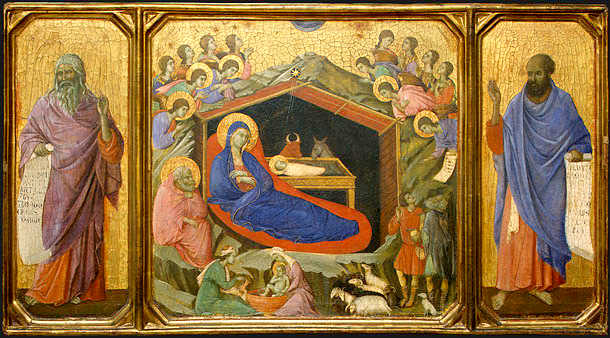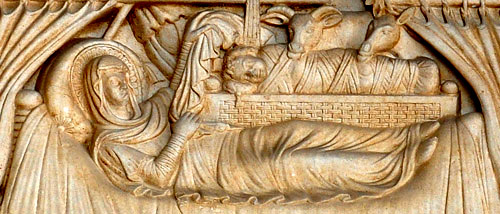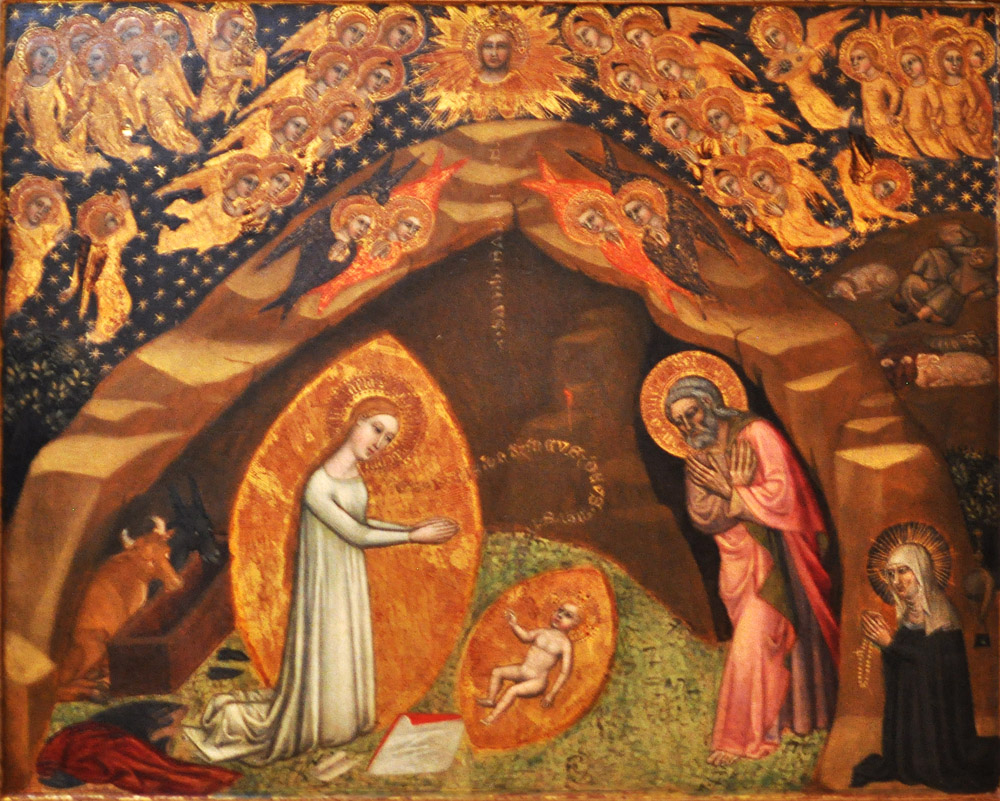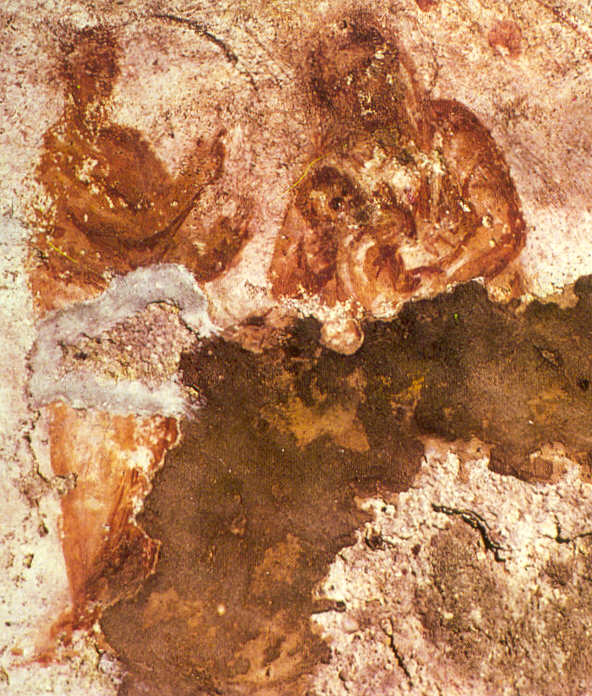
It was further believed that the star of Balaam's prophecy was the one that led the Magi of Matthew 2 to the child, so in the 4th century these men are often pictured in a line approaching Mary, who sits on a throne with the child on her lap:

These Magi images are sometimes paired with another type based on Isaiah 1:3: "The ox knoweth his owner, and the ass his master's crib [Latin praesepio domini]." This was seen as a prophecy of Mary's putting the child "in a manger" (in praesepio) after the birth (Luke 2:7). The Gospel of Pseudo-Mathew, for example, says, "the ox and the ass adored Him. Then was fulfilled that which was said by Isaiah the prophet, saying: The ox knoweth his owner, and the ass his master’s crib" (¶14).
This interpretation of Isaiah's remark explains the inclusion of an ox and ass in the oldest known sculpture of the Nativity (top of this page) and in nearly all subsequent images of Jesus' birth. In the image no human persons are in attendance, even Mary: the two beasts are what matter, because they affirm the fulfillment of prophecy. Subsequent images in the 4th century continue for a while to keep the stable scene confined to just the child and the animals, with Mary or a single shepherd off to the side
(example).
The birds in the image at the top of this page feed on baskets of bread, a clear reference to the Eucharist. In later works, however, the Eucharistic significance of the Nativity is symbolized by the ox and ass. The exegetes interpreted these animals at their feeding trough as symbols of the Christian faithful who are nourished by the "fodder" of Christ's flesh.2 Accordingly, in many images from at least the 8th century the two beasts actually "feed" on the child, licking his body or nibbling at his fingers, as in
this sculpture.
After the 4th century the iconographic tradition adds Joseph and two midwives, and eventually numerous other figures, as in the Duccio above. Often Mary is pictured lying in bed, parallel to but separate from the manger with the two beasts.

In the Orthodox and early medieval iconography Joseph is almost always seated with his left cheek resting on his left hand, as if he were perplexed or worried. In many Orthodox icons he is addressed by an old man in a woolen garment
(example) who according to Tradigo (106) is a "shepherd-demon, who is driven away by a mysterious youth; the youth then accompanies Mary and Joseph on their flight into Egypt with the Child." I have found no Orthodox Nativity in which anyone chases the old man away. Nor does of the many apocryphal accounts of the Nativity in Schneemelcher mention any man addressing Joseph at this point. In a few Orthodox icons the same old man is clearly one of the shepherds come to adore the Child.
The Adoration of the Christ Child
In the last quarter of the 14th century an influential memoir by St. Bridget of Sweden leads to a sharp change in the iconography: Joseph and Mary now kneel before the Christ Child, who lies naked on the ground before them. Often light will radiate from his body, outshining the light of a candle Joseph has brought. All this comes from a passage in the memoir where Bridget recounts a vision she had when she visited the Nativity Cave in Bethlehem:When they [Joseph and Mary] had entered the cave, and after the ox and the ass had been tied to the manger, the old man went outside and brought to the Virgin a lighted candle and fixed it in the wall and went outside in order not to be personally present at the birth. And so the Virgin then took the shoes from her feet, put off the white mantle that covered her, removed the veil from her head, and laid these things beside her, remaining in only her tunic, with her most beautiful hair – as if of gold – spread out upon her shoulder blades.…The rapid acceptance of St. Bridget's account may have been facilitated by its resemblance to the Book of the Infancy of the Savior and its primary source, the Gospel of Pseudo Matthew.4 In both Bridget and the Infancy, Mary lifts her face to Heaven just before the birth and adores the child immediately after. Both narratives note the remarkable cleanness of the child's body, "not begrimed as other infants are when they are born covered in filth," as the Infancy puts it. In all three narratives, the location is a cave and Joseph is away when the birth occurs.
And when all these things had thus been prepared, then the Virgin knelt with great reverence, putting herself at prayer; and she kept her back toward the manger and her face lifted to heaven toward the east.….and then and there, in a moment and the twinkling of an eye, she gave birth to a Son, from whom there went out such great and ineffable light and splendor that the sun could not be compared to it.
[After the birth] I saw that glorious infant lying on the earth, naked and glowing in the greatest of neatness.… When therefore the Virgin felt that she had now given birth, at once, having bowed her head and joined her hands, with great dignity and reverence she adored the boy.… When these things therefore were accomplished, the old man [Joseph] entered; and prostrating on the earth, he adored him on bended knee and wept for joy.3
Most tellingly, all three compare the light in the cave to the sun. For Bridget the child gives off a light so great "that the sun could not be compared to it." In the Infancy he gives off a "light that outshone the sun" and in Pseudo Matthew the cave is bathed in light "as bright as if the sun were in it." The brilliant light is a detail unseen in Nativity images before Bridget, as is Mary's posture of adoration. The child's nakedness, another feature of the images after Bridget, is explicitly mentioned only in her account, but it is presupposed in the Infancy by the midwife's amazement at the emanating light and the cleanliness of the body.

These details were enormously popular in the art of the 15th century (example, exception) and the 16th (example). They continue to dominate the iconography even today, when most Nativity scenes on Christmas cards have Mary kneeling to the Christ Child. In many of these the baby glows just as in Bridget's vision.
In 1570 Molanus (De Historia, 396) condemned picturing the baby as naked, but his influence in this case was of limited effect: the child is completely naked in almost half of the Nativities listed at the Web Gallery of Art for 1570-1670 (example).
The representation of St. Joseph was also revolutionized by Bridget's vision. Before Bridget the images usually picture him off to the left or right with his hand held against his cheek (example). But after Bridget he usually stands with the candle mentioned in the vision and/or joins Mary in kneeling before the Christ Child. The 2nd-century Protevangelium of James (¶20-21) tells of two midwives who attended Mary, so from the 5th century onward the two became a staple of eastern Nativities (Schiller, I, 65). In the story the midwife named Salome doubts Mary's virginity and tests it with her finger. In consequence, her hand starts "dropping off as if burned with fire." But upon her praying God for a cure an angel comes and says she can have her hand whole if she just touches the baby. Cartlidge and Elliott (90-93) study images that portray this episode.
Most often, though, the midwives are simply pictured washing the baby in a tub. Sometimes the tub may be shaped like a round baptismal font, as in this altar screen from the 11th century.
But the notion that the newborn Savior would need a bath was inconsistent with the way writers in the West imagined the virgin birth. As early as 383, Jerome insisted that "No midwife assisted at his birth.… [Mary] laid him, we are told, in a manger, because there was no room for them in the inn, a statement which…refutes the ravings of the apocryphal accounts, for Mary herself wrapped him in the swaddling clothes" (Against Helvidius, ¶10). In the 12th century Honorius of Autun seconded the tradition that "the Blessed Virgin gave birth to him…without pain and without the stain of childbirth" (Speculum Ecclesiae, 817). Molanus condemned the picturing of midwives in 1570 (De Historia, 396). But most effective of all was Bridget of Sweden's personal vision of Mary giving birth alone "in a moment and the twinkling of an eye."
This insistence on a "clean" and bloodless birth combines in the 14th century with a changing aesthetic sensibility that emphasizes the beholder's response to the Savior, and in the course of that century the midwives gradually disappear from Nativities in the West. Duccio's Nativity (see above) reduces them to a design element, part of the halo of figures that surrounds and focuses attention on the mother and child. And Giotto's fresco allows only one midwife to poke her head into the frame from the left. Bartolo di Fredi's Nativities of 1374 and 1383 have no midwives at all.
The Announcement to the Shepherds
The shepherds are often pictured receiving the message about the birth in a secondary scene to the left or right of the manger scene (example) or in an independent image. One of the most moving examples of the latter is Jean Poyet's miniature in The Hours of Henry VIII (Wieck, 102). The shepherds sit on a rise with their backs to the viewer, leaving a space between them so we can enter the scene in our imagination and look with them across the flock below to a vision of the angels singing "Gloria in Excelsis." Most other images of the announcement, however, picture a single angel surprising the shepherds with his message (example). These images correspond to the first verses of Luke's account: "And behold an angel of the Lord stood by them, and the brightness of God shone round about them; and they feared with a great fear. And the angel said to them: Fear not; for, behold, I bring you good tidings of great joy, that shall be to all the people" (2:9-10).Some images evoke the shepherds' initial fear through gestures, as in this detail from a predella of the 15th century. But usually the reaction is more neutral, as if in response to the angel's "fear not." (The image at the top of this page would be an example.)
In the 15th century dogs are sometimes in the picture. They bark angrily at the intrusion of the angel in Orcagna's fresco at Santa Maria Novella and in this painting in Rome's Musei Capitolini. In Poyet's Hours of Mary of England (Wieck, 26) the dog bays at the heavenly host, but in his Henry VIII (ibid.) it sits contentedly at the shepherds' feet and watches the spectacle with them.
The Henry VIII image is quite unusual in that one of the three shepherds is in fact a shepherdess, holding a distaff and wearing a dress and apron. There may be other examples with women shepherdesses, but I have seen none as yet.
The Adoration of the Shepherds
More common than the announcement images is the type usually labeled as the Adoration of the Shepherds. This type often echoes the Adoration of the Magi, with precisely three shepherds differentiated by age – a youth, an old man, and one in middle age. Like the Magi, shepherds from the 14th century onward may bring the child a gift. In the English mystery plays the gifts are small and humble, but in paintings the men are more likely to bring a lamb (example).Unlike the midwives, the men pictured adoring the Christ Child can be made to model the joyful response that many late Gothic and Renaissance Nativities strive to inspire in the viewer, for example in this sculpture group from the 15th century and this painting from the 16th, where the smiling shepherd in blue appears to be carrying a bagpipe on his back. Bagpipes and other instruments amplify the emphasis on the joy of the savior's birth. In Bronzino's Adoration an old shepherd has a bagpipe on his back, and in this sculpture the instrument is a flute. In the Shepherds Play at Chester it is a horn, and in the York play the shepherds respond to the angels with song of their own.5
Unfortunately many medieval images of the shepherds tend to reflect the prejudices of the age, making them look like crude yokels and blocking them off architecturally from the central scene, as in this Nativity from the 15th or early 16th century. But from they begin to be accorded more dignity the mid-16th century (example) into modern times (example).
Prepared in 2014 by Richard Stracke, Emeritus Professor of English, Augusta University, revised 2015-12-03, 2016-09-17, 2016-11-12, 2017-10-26, 2018-02-27, 2020-01-29, 2020-05-20, 2020-08-08, 2020-10-18, 2021-03-22, 2021-03-30 2021-12-19.
HOME PAGE
A detail of the so-called Sarcophagus of Stilicho, 3rd century. See the description page for details.
MORE IMAGES

Wall painting in the Catacomb of Priscilla, Rome: Balaam on the left points to a star above Mary and the baby. (See the description .)
- Fourth century: Sarcophagus fragment with Mary, the baby in the manger, and the ass munching at the manger.
- 330-335: A relief on the Sarcophagus of Marcus Claudianus: the ox and ass inside with the child, the shepherd outside in contemplation.
- Fifth century: In this ivory plaque St. Joseph wears just a working man's tunic and holds a saw emblematic of his trade. He and Mary sit left and right of the manger.
- 6th century: The Nativity image on a reliquary box from Palestine.
- 1160-1180: The Nativity is the second of the ten panels outlining the Life of Christ on this portable altar.
- First quarter of the 13th century: A highly stylized enamel with a seated Joseph and recumbent mother and child. The Metropolitan Museum has a similar enamel from 1165 with the figures disposed in the same way (accession number 17.190.418).
- Mid-13th century: In a manuscript illumination Mary's arm crosses the space that had traditionally separated her from the child in the manger.
- Second half of the 13th century: The Nativity's place in salvation history is the subject of this manuscript illumination.
- 1291: Apse mosaics in Santa Maria in Trastevere, with three Nativity subjects.
- 13th/14th century: An Austrian fresco in the traditional iconography.
- First half of 14th century: Relief on the façade of Orvieto Cathedral, retaining the midwives but putting them to the 14th-century purpose of inspiring wonder and joy.
- 1325-70: Panels 3 and 4, window 3 in Regensburg Cathedral's Life of Mary Windows
- 1344: Detail from Guariento di Arpo's Coronation of the Virgin altarpiece.
- 1376: One of the last Western Nativities with a midwife.
- 1390-1420: Pietro di Miniato's Annunciation includes a small Nativity image with Bridget of Sweden joining in the adoration of the Christ Child.
- 1414: A predella panel in Lorenzo Monaco's Coronation of the Virgin with Saints.
- 1420-23: A "Madonna of Humility" Nativity scene.
- mid-15th century: Van der Weyden's huge Polyptych of the Nativity covers five Nativity episodes plus the Fall of Man.
- 1446: The Nativity in an Initial H, from an antiphonary in Florence.
- 1463: In Filippo Lippi's Adoration of the Christ Child the usual details of a Brigittine Nativity are replaced by an imaginary setting in which the child's divinity is announced by the Father, Holy Spirit, and John the Baptist.
- 1474: A fresco in Croatia using details from Bridget's vision and some from the earlier tradition.
- 1475-80: Botticelli's Nativity has the Brigittine kneeling Mary and glowing child, but also kneeling is a child John the Baptist already in a camel skin.
- 1479: The Nativity is pictured in the open state of Memling's Jan Floreins Triptych.
- late 15th/early 16th century: Mazzolino's simple, quiet take on the subject.
- 1500-1520: Christ is Born as Man's Redeemer, a vast allegory in tapestry.
- 16th century: Fresco in Istria (Northwest Croatia).
- 16th century: A Nativity partly Bridgettine in inspiration and partly based on earlier traditions.
- 16th century (?): A painting in the church of San Luigi Francesi, Rome. Its label says it is "of uncertain paternity." The kneeling angel is a 16th-century innovation.
- 1515-20: Detail from Fifteen Mysteries of the Rosary by Goswijn van der Weyden.
- 17th century: Andrea Pozzo's The Census in Bethlehem.
- 1895: Detail from Josef Dettlinger's archaizing Marienaltar.
- 20th century: The ox and ass continue to be a feature of modern Nativity images such as this sculpture in the Nativity Portal of the Sagrada Família in Barcelona.
- 1434-45: A Coptic Nativity image with Balaam, the Magi, the ass, and two oxen.
MORE IMAGES: ADORATION OF THE SHEPHERDS
- Third quarter of the 11th century: Ivory reliquary with the shepherds giving gifts to the child, a topic seen from time to time throughout the Middle Ages. As in the images on the 4th-century sarcophagi and the early catacomb painting, Mary is seated.
- 14th century (?): A relief of the Adoration of the Shepherds, with only two shepherds?
- 1476-78: Hugo van der Goes's triptych, The Adoration of the Shepherds adds the Portinari family and their patron saints to an already well-attended Nativity scene.
- 1488-90: Pinturicchio's Nativity is one of many examples in which the three shepherds represent the three ages of man.
- 1568: Jacopo Bassano, Adoration of the Shepherds with St. Corona.
- 1578-81: Tintoretto's bold reimagining of Adoration of the Shepherds iconography.
- 1599: Cigoli's Adoration of the Shepherds with St. Catherine of Alexandria includes that saint and St. Anthony Abbot.
- Post-16th? A predella panel in Croatia.
- 18th century (est.): Adoration of the Shepherds including a divine commendation by the Father and the Holy Spirit.
NATIVITY TEXTS RELEVANT TO THE IMAGES
- The Gospel of Pseudo-Matthew
- The Protevangelium of James
- Golden Legend #6: html or pdf
ALSO SEE
NOTES
1 See the Glossa Ordinaria, I, 1360-62. In the Tridentine masses for Christmas the introits and communion verses were all taken from texts of Isaiah and the Psalms thought to be predictive of the Nativity. See the Missale Romanum, 16-20. And the Mirror of Human Salvation (32-33, chapter 8) cites a number of presumed prophecies from those two sources. In dramatic works a succession of prophets would step forward and tell their prophecy as a prelude to the Nativity or the Annunciation. See the Benediktbeuern Nativity (Bevington, 180-201), the Annunciation play in the Towneley Cycle, and the Nativity play in the Chester Cycle.
2 Luke 2:7,12,16. Mâle (185) quotes the Glossa Ordinaria on Luke 2:7 as saying, "She put him in a manger, that is, the body of Christ on the altar." I have not found this comment in either the Lollard Society's online copy of the Glossa or in Migne's edition, but see for example Gregory the Great's homily on Luke 2, which says, "Thus he is born and lies in a manger, so that all the faithful (that is, the holy animals) may be refreshed by the grain that is his flesh" (Migne, Pat. Lat. LXXVI, 1104). Honorius (Speculum Ecclesiae, 818): "The ass, (interpreted as the Gentiles) and the ox (interpreted as the Jews) are led by faith to eat the body of Christ." Similarly, see pseudo-Bede (Migne XCII, 331) "He who is the bread of angels lay in the manger so he could nourish us as holy animals with the fodder of his flesh". (All translations mine.) See especially Leah Marcus on the influence of these interpretations on medieval art and the English cycle plays.
3 Bridget of Sweden, Prophecies and Revelations, VII, 21.
4 The Book of the Infancy of the Savior goes by a variety of names in the scholarly literature. It can be consulted in M. L. James, Latin Infancy Gospels, where sections 62-75 cover the Nativity. Bradley's online commentary includes a partial translation into English, and Santos Otero translates the Nativity and Magi sections into Spanish in Los Evangelios Apócrifos, 110-117. Santos Otero suggests a date in the 9th century. Its principal source is the Gospel of Pseudo Matthew, which has been dated anywhere from the 5th to the 9th century; but James (xxiv-xxv) posits an additional source dating to the 2nd century on the basis of the book's apparently
"docetic"
"Docetism" holds that the Christ was a spiritual being who only appeared to be a physical presence.
passages, especially the midwife's statement that a light descended from Heaven, formed itself into the shape of a child, and entered Mary, who then gave birth. Also suspiciously docetic is the child's apparent weightlessness when the midwife holds him in her arms. And her detailed insistence that the birth did not impair Mary's virginity, although consistent with orthodox teaching, could nevertheless have arisen from a docetic belief that what seemed a physical parturition was only an illusion.
5 Deimling, I, 138-39. Bevington, 380; and compare the song of the Towneley shepherds that precedes the Mak episode, ibid., 390.
